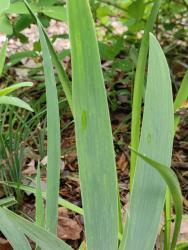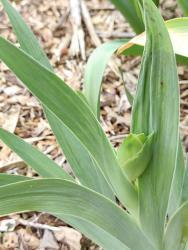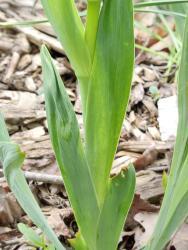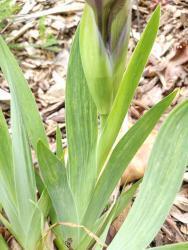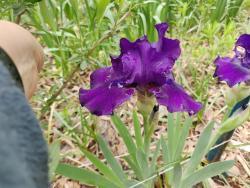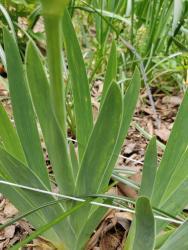Back with an update. This IS indeed a mosaic virus. I thought it would be helpful to come back and let other people know, so they have pictures for reference, and also to tell folks here what I have learned about the viruses that infect iris. SO there is a very long post below, if you are interested.
I had a hard time believing this was due to aphid damage, as the aphids in the picture were the very first ones I had seen in the garden this spring. We had no fungal signs, so that was not on the table. It kept bothering me, so I emailed the grower as well to inquire if they recognized the symptoms and had any problems with viral infection in their nursery, and I'm afraid their response demonstrated total ignorance of viral infection in iris. They did not know the difference between a virus and a fungus. They told me it was too hot and dry for viruses where they were and advised me to try a fungicide. Thsi response was what prompted me to test the plants after all--if the grower was unaware that viral infection was even possible, that seemed a very bad sign. After obsessively reading scientific literature on plant viruses, I eventually I broke down, and shelled out for actual virus testing supplies.
It's a potyvirus, most likely Iris Severe Mosaic Virus (ISMV), but I didn't bother finding out for sure exactly which one. Testing is expensive, and the outcome for any viral infection is the same: destroy the plant. The only reason I would need to know the exact virus would be to know the range of other plants that might be infected, and the handful of potyviruses that infect irises all have pretty much identical host ranges. Unlike most animal viruses, plant viruses can infect many species. This particular family of viruses infect most of the spring bulbs: tulips, allium, daffodils, crocus and nerine. Tazetta daffodils are especially susceptible, and unfortunately I believe many or most of mine became infected. Testing becomes unreliable once the leaves are senescing, so I will have to wait for next spring to be sure I have eliminated everything that is carrying it.
These potyviruses are spread mostly by aphids, but possibly by other leaf sucking insects as well, such as leaf-hoppers. Its also possible to spread the virus during planting or dividing or any other such operation where you can introduce sap from one plant into another via infected tools and soil touching the wounds on broken roots and leaves.
It is easy to miss these infections! As you can see in the pictures above, the visual symptoms can be quite subtle--some varieties showed lots of mottling and mosaic--its most noticeable on the purple and yellow "What, again?" --and others only a faint amount, just a hint on some of the leaves. If it has not been so apparent on What, again I would probably not have even noticed it on the others at first. Many varieties of iris can tolerate viral infections with only very mild symptoms and continue to bloom and grow. However, infections do weaken the plant, causing stunting, fewer and smaller blooms, and more susceptibility to bacterial and fungal infections. And they can be absolutely devastating to the other types of plants they infect--my tazettas were quite ruined and pathetic. After reading quite a lot on these forums and scrutinizing foliage pictures, I suspect that some performance differences folks frequently attribute to climate -- plants that never reach their advertised height, varieties that are slow growers and bad bloomers even though other report they proliferate, mystery deaths, etc.--may in some cases be undetected viral infections. I certainly see photos of plants with lovely blooms, but clearly symptomatic foliage.
In addition to that, the viral symptoms tend to clear up at least partially in the summer, because these viruses stop replicating around 85 degrees F. However, the infection is not gone, even if the plant looks healthy again. Plants do not recover from viruses like animals. Plant viruses are all incurable. It will resume replicating in the fall. Infected plants must be destroyed to prevent infecting others. They should be thrown in the garbage or burned, not composted, as some viruses can persist in composting plant matter and soil for years. These potyviruses are relatively unstable, thankfully, and do not persist for a very long time in the soil where the plant was removed--two years at most. I plan to find and eliminate any bulb that emerges looking symptomatic next spring, and then wait an additional year before I plant anything new that could become infected.
The scientific literature shows that random testing finds that these viruses are widespread in nursery stock iris. I have been surprised to learn how little regulation there is in the US requiring virus testing by growers of ornamental plants. Mostly, growers are not obligated to test routinely for viral infections, and anything that does not look sick can be presumed healthy. Since many infected iris can continue to grow and bloom relatively normally, there is very little virus testing in iris except by the very large commercial growers, and typically only for the bulbous iris that are important to the florist trade. It's simply economically not worthwhile for growers to worry about if they are not producing the other bulbs that can be infected--and almost all the bulb trade is overseas.
So I suspect this came from the grower, but I'm not a 100% sure. I had not noticed any previous signs in my garden, and every single plant from the order was infected, about ten varieties, despite planting in two quite separate locations. I have not seen any other visible cases in my neighborhood (and I'm sure the neighbors all think I am crazy based on how I started minutely examining every clump of iris I saw in the surrounding blocks) . However, it is possible they acquired a virus here during that first fall they are planted in before I saw the signs in the spring. Its nature out there. Stuff happens. But any new iris I acquire after the garden convalescence period are going straight into pots for their first season, I can tell you that! I will get a good look at the spring foliage before they have an chance mingle with the rest of the garden--my spouse is now laughing about the naughty, dirty iris corrupting our innocent daffodils.

Also, side note: it is VERY hard to search this forum for information about viral infections of iris, because of all the people referring to the "iris virus" they have caught themselves! You've boggled Google with that one!
Anyway, I hope this is helpful to others, and I look forward to restarting my iris adventure in another year or two, hopefully virus free.
